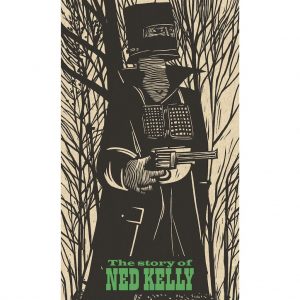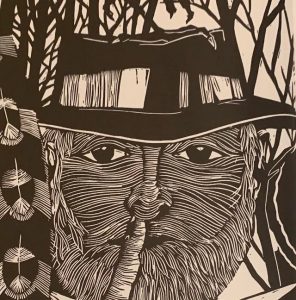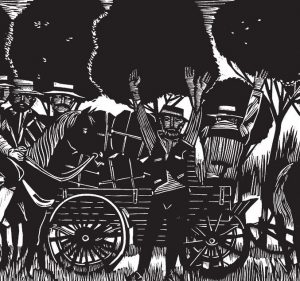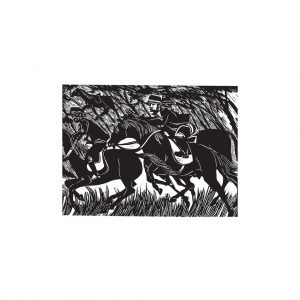
“The story of Ned Kelly”
by Marie-Ève de Grave (text)
and Jean-Jaques de Grave (linocut etchings).
Five Mile Press, October 2020.
Reviewed by Stuart.
Browsing my library’s catalogue I spotted this recent illustrated book and thought I should have a look at how the Kelly story was being presented in France in 2017.This 2020 English translation sells for $12 at K-Mart.
Five Mile Press describe it as “A powerful graphic novel that breathes new life into the story of Ned Kelly as told by French film maker and screenwriter Marie-Ève de Grave, and illustrated with the impressive engravings of her late father, Belgian artist Jean-Jacques de Grave. Its evocative engravings tell the story of Ned Kelly from his point of view.”

The linocut engravings are in fact brilliantly done, although the portrait of Kelly at the front seems to show him picking his nose. The end notes say that the engravings were inspired by the engraver’s “reading of Peter Carey’s fictionalised autobiography of Ned Kelly”, but the end Timeline states that “The graphic novel account of the story of Ned Kelly you have just read is based on true events, the details for which remain the subject of debate by historians even today.” It appears from these two statements that the text purports to be a reasonably true account regardless that the illustrations are based on reading Carey’s fiction. So let us see how the dice fall, given that nothing clearly indicates to the reader in the title or at the start of the book that this is going to be a fictionalised account.
This review highlights a number of problems with the text. The story is set in northeast Victoria, where “the air echoes with songs of kookaburras and kingfishers, cries of possums and calls of bandicoots”. The author/s are Europeans, so maybe not sure what was making the “cries of possums and calls of bandicoots” that echoed through the scrub during their visits. But it certainly wasn’t possums and bandicoots which are mostly quiet little critters. Maybe a bunyip?
The “frontier land of the southern hemisphere was a place where convicts, gold prospectors, indigenous peoples and police officers came together.” I don’t think they checked that line with any indigenous people, who might have something to say about it.
After the customary emphases on Irish Kellys and English lords we learn that the police had it in for the Kellys because they were Irish:“In this land, Irish people like us end up in the hole.” No mention that so was about 85 percent of the police force. People like the Kellys ended up “in the hole” because they were crooks, not because they were Irish. The text generalises about the police as “trigger happy”, against the fact that in that era the police generally went about their policing unarmed (see Haldane, ‘The People’s Force’).Maybe there is more Carey underpinning this text than there should be.
Of Harry Power it says, “he taught me how to fight and dodge. One day we robbed a stagecoach. … That night I became a man.” A strange conception of manhood; real men were building new lives in their new land; Kelly was becoming an apprentice vulture. It was not a career move: “At sixteen
years old, the coppers sent me to prison in Wangaratta” for horse theft. That would be the well-known Wangaratta gaol? You know the one? Big tourist attraction, can’t miss it?

“Three years in chains, breaking stones.” Then, his mothers’ lament, “clasping my hand through the bars.” Gee, those Wangaratta warders were heartless. Maybe the writer meant Beechworth and Pentridge gaol as Kelly ranted about in his Euroa and Jerilderie letters? And no visits from mummy.
But all was well on his release: “My mother had moved in with George King, a horse thief.” Or maybe he with her, since she was still at the Eleven Mile.
“Jim had vanished.” Yes, because he was doing time in NSW, but we won’t mention that.
“During the night we heard him [Constable Fitzpatrick]
prowling, drunk, around the farm. The worst part was that he ogled Kate. One evening I caught him groping her wildly in front of everyone. ‘Fitzy, if you touch one more hair on her head you’re dead! As true as my name is Ned Kelly!’ The bastard left, slamming the door behind him.” The endless repetition of utter bilge by writers who claim to have researched the Kelly story continues as still more readers are deprived of any notion that the Kate story is unhistorical fiction. The nonsense centrally pushed to prominence by Jones in ‘Short Life’ yet again obstructs corroborated historical fact and understanding. (Time to plug my ‘Redeeming Fitzpatrick’ article again; google to find it.)
“Two days later, Fitzpatrick stumbled into Eleven Mile Creek brandishing a colt revolver. He was drunk and wanted Dan.” I was going to send this back to the library at this point, but thought that as I’d got that far (about a third), I ought to see if it gets any worse. It did.
“Dan joined me in the Wombat Ranges. I had set up camp around Stringybark Creek.” Make that Bullock Creek – a mile and a half away? Does anyone care? The “coppers had set up camp 500 metres away. … The coppers were drunk. We heard them crashing through the bush.” Is this in Carey? Carey can’t be that bad too, surely? Then the attack: “Constable Lonigan had already drawn his weapon. Lonigan fired first. I dodged and returned fire. The copper died immediately. After that there was a gun battle. … Two coppers were dead and one escaped.” This is so bad, even the linocuts repeatedly show only three police. I had to check Carey (Vintage edn, p. 318), and he definitely had all four police at SBC. How this three police nonsense got past an editor I have no idea.
But it gets worse.
“The day of the Euroa robbery … Early in the morning we arrived at Younghusband’s Station, a small tavern on the edge of the town’s centre. It was full and noisy with about fifteen people, mostly workers, seated in front of their beer.” Yes, really, it sounds like maybe a tavern in a French provincial town? Extraordinary, that. Nothing like the Faithfull’s Creek Station presented in Carey p.389, “three miles along the railway line from Euroa” and not a pub at all.

Can it get even worse?
Yes, after the robbery they addressed the crowd and left for the bush. “We had won our first supporters.We were happy: we would build a fairer society.” Seriously, that’s what it says.
And then, “All those who knew us from near or afar were arrested and imprisoned. The state also confiscated their land for six months.” Has the Chablis got our author floored? Just wait till Jerilderie:
“On the Sunday evening we barricaded ourselves in the Royal Hotel. There, in front of 30 witnesses I dictated a letter to Joe Byrne, the Jerilderie Letter … about freedom; about democracy”, stuff which doesn’t appear anywhere in the Jerilderie letter. “When Joe explained that our intention was to rob the bank and share the loot to all those who had been locked up and deprived of their land, we received an ovation. In a single night we had become the angels of a new nation.”
Can I read any more of this nonsense? I’m only halfway through, but fortunately the text is relatively short as the
magnificent illustrations occupy the large part of the book.
“We took refuge in the Bogong High Plains… and talked about reinventing the world, where all men would be equal, whatever their origin.” I’m surprised they weren’t all singing the Marseillaise.
At Glenrowan, “We wanted to … proclaim the independence of the state and force the release of my mother.” In that order, thank you. Any naysayers new to this blog can google “Ned Kelly and the myth of a republic of north-eastern Victoria” for a free myth-busting book. (or click the link at the top of this Page)
We are next told that Ned thinks he is “the protector of the poor and the oppressed”, a claim for which there is no
evidence anywhere in anything he ever said except by gross distortion from the Jerilderie letter.
After Glenrowan the book skips over Kelly’s trial to his execution, noting only that “My trial has been short,” and ends with “Such is life”. Anyone new to this blog can google “Ned Kelly’s last words dawson” and see this myth blown up too.
At last we finish the book with the photo of Kelly standing
against the gaol wall the day before his execution, with the facing page captioned, “Ned Kelly, the Australian anti-hero.”
In sum, the linocut illustrations are great, but the text is a serious disappointment. It seems like there is no longer any necessary connection between history and historical fiction. Kelly books seems to have moved to a place where facts don’t matter as far as the narrative goes, and that does no service to anyone with an interest in learning our history. The cover
should be clearly labelled ‘historical fiction’.

In my research and reading on Ned Kelly, I have come across numerous writings by so-called journalists, who seem to relish writing and promoting the myths, lies and falsehoods that proliferate in far too many publications, including government pages.
It is clear that not one of them has done any research at all, and they proudly waffle on with their fiction, which exposes them as the fools they are for following the fiction.
I have also read a number of books that are poorly researched and continue with myths, lies and fiction, that has been exposed for many years now.
There is one redeeming fact, and that is that the truth is beginning to win the argument. It will take a year or two more, but it is happening.
As Stuart has pointed out here, what a bunch of misfits wrote this rubbish.
Glad they have been exposed.
A terrific review. I really enjoyed that and got quite a few needed laughs. Mega-kudos to Stuart Dawson. I also agree about the woodcut illustrations, those are terrific, though I at first glance thought Ned was doing the “shush, don’t ask and don’t tell” sign rather than picking his nose. 😉
Thanks Sharon, I have to give David credit for putting up all the other scans though! That one still looks more of a nose pick than a shush sign to me, but I sort of see what you mean when the whole image is seen as attached. But no, definitely nose-picking, it’s too far up to be just shushing. I’ve never seen anyone shush with their finger tip up their nose.
I remember the story about Maggie Skillion putting her thumb on her nose and waggling her fingers at the police when they followed her up a hill. Maybe it’s a reflection on that universal symbolism. It’s in the Royal Commission Minutes of Evidence Q. 1581, “It was a great ascent, at the back of the house, and those men on foot followed, thinking they had a splendid clue. She had a bundle in front of her. When they got to the top, there was Mrs. Skillion, sitting on a log, with her fingers to her nose, making fun of them.” We have to get the scholarship right on this sort of thing. That would have made a great linocut. Maybe I’ll have a go myself.
Attachment
Stuart, thanks for the full on image, it is an odd illustration no matter which way one slices one. Oh, yes, I knew about Maggie and her “c*cking a snook” at the traps. 😉
Yes, and of perhaps dubious relevance but also hilarious is Rabelais’ Gargantua and Pantagruel, Book 2, Chapter 19, “How Panurge confounded the Englishman who argued by Signs”. Maggie’s gesture is in there, along with a lot of others!